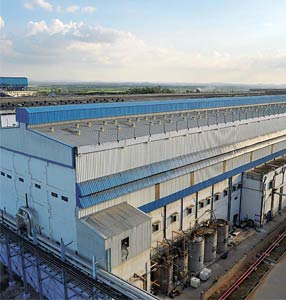 ITC continued to invest in reducing air emission levels through adoption of cleaner technologies/ fuels, monitoring of combustion efficiencies and investment in state-of-the-art pollution control equipments such as plasma filters, electrostatic precipitators, etc. ITC continued to invest in reducing air emission levels through adoption of cleaner technologies/ fuels, monitoring of combustion efficiencies and investment in state-of-the-art pollution control equipments such as plasma filters, electrostatic precipitators, etc.
All our Units monitor significant air emission parameters such as Particulate Matter (PM), Nitrogen Oxides (NOX) and Sulphur Dioxide (SO2) on a regular basis, to ensure compliance with internal norms that are more stringent than regulatory requirements.
In 2010-11, the total significant air emissions included 765 tonnes of Particulate Matter (PM), 874 tonnes of NOX and 1133 tonnes of SO2 emissions (In 2009-10, PM : 880 tonnes, NOX : 811 and SO2 : 909 tonnes). The increase in the total emissions is mainly due to significant growth in production volumes in almost all businesses; Paperboards Business up by 2.9%, Foods’ Business snacks and biscuits by 94% and 25.8% respectively and soaps in Personal Care by 27.8%.
In 2010-11, Particulate Matter emissions from Bhadrachalam were 1.32 Kg per BDMT (Bone-Dry Metric Tonne) of production, an improvement of 14% over last year (1.54 kg/BDMT in 2009-10). As per the report by Centre for Science & Environment, large-scale Indian mills typically emit 3.8 kg/BDMT (Source: ‘All About Paper - The life cycle of Indian Pulp and Paper Industry’, Green Rating project, 2004).
| In 2010-11, the specific NOx emission in
Bhadrachalam was better than the standards
stipulated in European countries, as illustrated
below: |
|
Specific SO2 emission level of Bhadrachalam Unit
is comparable with international benchmarks
and the Unit is working towards achieving these
international standards. |
| |
|
|
| |
NOx (Kg/tonne) |
| Bhadrachalam |
2007-
08 |
2008-
09 |
2009-
10 |
2010-
11 |
| |
0.43 |
0.69 |
0.60 |
0.58 |
| Standards |
| Sweden |
1.2-2.4 |
| EU |
1.0-1.8 |
| EU-BAT* |
1.0-1.5 |
| Reported Values |
| CEPI** |
0.84 |
|
|
| |
SO2 (Kg/tonne) |
| Bhadrachalam |
2007-
08 |
2008-
09 |
2009-
10 |
2010-
11 |
| |
0.5 |
0.84 |
0.79 |
0.74 |
| Standards |
| Sweden |
0.5-1.4 |
| EU |
0.1-0.5 |
| EU-BAT* |
0.2-0.4 |
| Reported Values |
| CEPI** |
0.29 |
|
Sources–
1. Comprehensive Industry Document for Large Scale Pulp & Paper Mills, study done by CPPRI, published by CPCB, 2007
*EU-BAT:EU Norm Best Available technology
2. **CEPI - Confederation of European Paper Industries, Sustainability Report 2009
 In addition to the above parameters, Bhadrachalam Unit also monitors Hydrogen Sulphide. The average measured value for the year 2010-11 was 8.99 mg/Nm3, lower than the regulatory norm of 10 mg/Nm3. In addition to the above parameters, Bhadrachalam Unit also monitors Hydrogen Sulphide. The average measured value for the year 2010-11 was 8.99 mg/Nm3, lower than the regulatory norm of 10 mg/Nm3.
|

